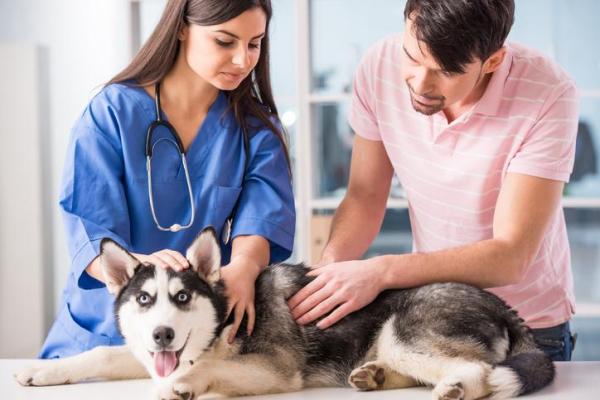Prostate Cancer in Dogs Symptoms



See files for Dogs
Knowing the symptoms of prostate cancer in dogs will make you best able to catch this deadly disease early. Early detection leads to a quicker diagnosis and a better prognosis for the canine. Unfortunately, many of the symptoms of this disease do not manifest until the cancer has advanced. This is why taking our dog to the veterinarian for regular check ups, not just when we see symptoms of a pathology, is so important. They will be able to determine if the condition is cancerous or whether a different condition is affecting the gland.
Once our dog has a positive diagnosis, we can also look into treatment of prostate cancer in dogs to see which need to be considered. AnimalWised discusses the background of prostate cancer in dogs to help in best preventing its occurrence.
Do dogs have a prostate?
Yes, male dogs do have a prostate gland. The prostate is a small gland located near the bladder and surrounding the urethra. This is the tube that carries urine and semen out of the body. The prostate gland in dogs plays a role in reproductive function as it produces and secretes fluids that are part of semen. For this reason, female dogs do not have a prostate and cannot develop prostate cancer.
The surrounds the urethra below the bladder and is a bilobed structure, i.e. it consists of two lobes. During rectal exams it is felt in the upper part of this area. If you want to know where is the prostate located in a dog, you can get an idea by looking below at our diagram of the urogenital system in dogs.
The prostate is an exocrine gland. Like all exocrine glands, it produces and secretes substances via a duct rather than into the blood stream. Those which secrete into the bloodstream are known as endocrine glands. The substance secreted by the prostate in dogs is used to help motility and ejaculation of sperm. There are several pathologies other than prostate cancer which can affect the prostate. Due to its location near the digestive tract, it can lead to problems with the elimination of urine and feces.

Can dogs get prostate cancer?
Yes, dogs can develop prostate cancer. Prostate cancer in dogs is relatively rare compared to humans, but it can occur. The exact incidence rates can vary depending on the specific population studied and geographical location. Additionally, the accurate determination of incidence rates can be challenging due to underreporting and lack of comprehensive data[1].
Based on available research and veterinary literature, here is a general understanding of prostate cancer rates in dogs:
- Overall incidence: prostate cancer is estimated to occur in less than 0.5% of all dogs.
- Age and neuter status: prostate cancer is more commonly seen in older intact (non-neutered) male dogs[2]. It is relatively uncommon in neutered dogs.
- Breed predisposition: some dog breeds have been reported to have a higher incidence of prostate cancer compared to others. These breeds include the Boxer, Doberman Pinscher, Rottweiler and English Bulldog.
- Risk factors: certain risk factors may increase the likelihood of developing prostate cancer in dogs, such as advanced age, hormonal imbalances, exposure to environmental toxins and genetic predisposition.
It's important to note that these figures are approximate and can vary. Additionally, advances in veterinary medicine and improved diagnostic techniques may lead to more accurate detection and reporting of prostate cancer cases in dogs.
Learn about other cancers in dogs with our article on symptoms and treatment of canine bone cancer.
Other prostate problems in dogs
In addition to prostate cancer, there are other issues which can affect the prostate of dogs. Some of these result in inflammation, but this does not necessarily mean there is a tumor. Some problems which may affect the canine prostate include:
- Prostatitis: this is a bacterial infection which usually occurs after cystitis. It can cause pain, fever, vomiting, diarrhea and excretions containing blood and/or pus. It is treated with antibiotics and castration is recommended.
- Benign prostatic hyperplasia: this is the uniform growth of the prostate which occurs more frequently in older dogs. it is related to hormonal activity, specifically testosterone. This is also usually treated with castration. After surgery, the prognosis is usually reduction in the size of the prostate and reduction in symptoms.
- Cancerous neoplasms: a neoplasm is an abnormal or excessive growth of tissue. In the prostate, it usually exists as a canine prostatic carcinoma which we will discuss further below. Not all are cancerous, as can be seen in hyperplasia, but they do not appear to be related to testosterone levels.
As stated above, Prostate cancer is something which more greatly affects older dogs, so age is a significant risk factor.
To arrive at a diagnosis, the veterinarian will need to carry out a rectal exam. They will also need to carry out some diagnostic tests. These may include:
- Ultrasound
- Urinalysis
- Biopsy
- Cytology
- Complete blood count (CBC)
Symptoms of prostate cancer in dogs
Due to the location of the prostate in dogs, it can often interfere with surrounding systems. As the cancer causes the prostate to enlarge, increased pressure is exerted onto the surrounding organs and tissue. When such pressure is applied to the urethra and rectum, there are likely to be repercussions in urination and defecation, respectively. Stools may appear flatter than usual and fecal compaction may occur.
It is also possible the dog may pee a little blood. However, this does not always occur during urination and they may secrete blood from the penis. In some cases, the dog is likely to have a hard time walking. If we see any of these symptoms we need to take them to the veterinarian.
One of the most affecting problems with prostate cancer in dogs is that it can be asymptomatic. This means you may not notice any alteration in their health until the cancer has spread (metastasized). After this time, it may show some end stage prostate cancer problems such as weight loss, loss of apetite, anorexia, vomiting or even paralysis. A full overview of the symptoms of prostate cancer in dogs includes:
- Vomiting
- Weight loss
- Trouble with urination (incontinence)
- Blood in feces
- Blood in urine
- Abnormal secretions from the penis
- Problems with gait while walking
- Fever
- Weakness
- Abnormal posture
- Pain
- Difficulty breathing
- Abnormal tail movement
- Flattened stool
- Paralysis, especially in hind quarters
- Scooting on the ground
- Tiredness

Treatment of prostate cancer in dogs
If the problem is a benign neoplasm such as benign prostatic hyperplasia, castration of the dog is recommended. This is because the cause of the growth is usually due to hormone production and removing the testicles lowers testosterone production. However, it does not appear that hormones do not cause canine prostate carcinoma, even if they may favor progression of the tumor[3]. It appears that some pathologies such as the aforementioned prostatitis and hyperplasia may exist prior to the appearance of prostate cancer in dogs.
When treating prostate cancer in dogs, surgery is generally not recommended. This is because the complications are vast and may cause serious harm to the dog's well-being and quality of life even if the cancer is removed. Radiotherapy and/or chemotherapy are more commonly administered as treatment, but it will depend on the stage to which the prostate cancer has developed.
As we have said, the main problem is recognizing the cancer when it is asymptomatic. In its advanced stage, the cancer will metastasize to the lymph nodes, lungs, liver, spleen or even bones. At this stage, prognosis is particularly bad an euthanasia may be recommend by the veterinarian.

How to prevent prostate cancer in dogs
Different breeds will have different health considerations to make with their overall care. Working dog breeds and those exposed to potential hazards may need to be brought to the veterinarian for more regular checkups. In general, all dogs should be taken to the vet at least once a year. When the dog reaches 7 years of age, it will be considered an elderly dog and should be taken more often for a general physical exam. This should include a prostate exam to ensure there is no enlargement of the gland.
Providing an adequate diet is also important for your dog and can contribute indirectly to reducing the possibility of prostate cancer. Frequent exercise is also important for overall canine health. If you would like to know more about reproduction related cancers in dogs, you may want to learn about transmisible venereal tumors.

This article is purely informative. AnimalWised does not have the authority to prescribe any veterinary treatment or create a diagnosis. We invite you to take your pet to the veterinarian if they are suffering from any condition or pain.
If you want to read similar articles to Prostate Cancer in Dogs Symptoms, we recommend you visit our Reproductive system diseases category.
1. Davis, B. W., & Ostrander, E. A. (2014). Domestic dogs and cancer research: a breed-based genomics approach. ILAR journal, 55(1), 59–68.
https://doi.org/10.1093/ilar/ilu017
2. Dobson J. M. (2013). Breed-predispositions to cancer in pedigree dogs. ISRN veterinary science, 2013, 941275.
https://doi.org/10.1155/2013/941275
3. Teske, E., Naan, E. C., van Dijk, E. M., Van Garderen, E., & Schalken, J. A. (2002). Canine prostate carcinoma: epidemiological evidence of an increased risk in castrated dogs. Molecular and cellular endocrinology, 197(1-2), 251–255.
https://doi.org/10.1016/s0303-7207(02)00261-7








